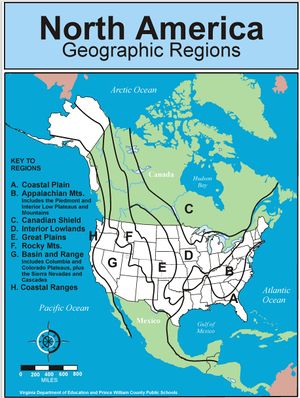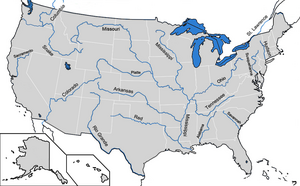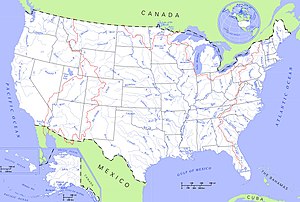Virginia and US History SOL map study: geography: Difference between revisions
m (Bromley moved page Virginia & US History SOL map study: geography to Virginia and US History SOL map study: geography: replacing ampersand with and) |
|||
| (3 intermediate revisions by the same user not shown) | |||
| Line 7: | Line 7: | ||
! | ! | ||
|- style="vertical-align:top;" | |- style="vertical-align:top;" | ||
|[[File:NorthAmerica-sel-regions LCPS VA-Edu.jpg|alt=|none|thumb|Major regions of North America from the Virginia Dept. of Education SOL framework document]] | |[[File:NorthAmerica-sel-regions LCPS VA-Edu.jpg|alt=Major regions of North America from the Virginia Dept. of Education SOL framework document|none|thumb|Major regions of North America from the Virginia Dept. of Education SOL framework document]] | ||
|'''Key''' | |'''Key''' | ||
*'''A) Coastal Plain''' | *'''A) Coastal Plain''' | ||
| Line 41: | Line 41: | ||
|- style="vertical-align:top;" | |- style="vertical-align:top;" | ||
| | | | ||
=== | === ATLANTIC COASTAL PLAIN === | ||
{| class="wikitable sortable mw-collapsible" | {| class="wikitable sortable mw-collapsible" | ||
|- style="vertical-align:top;" | |- style="vertical-align:top;" | ||
|[[File:Atlantic Coastal Plain.svg|thumb|The Atlantic coastal plain |alt=|border|none]] | |[[File:Atlantic Coastal Plain.svg|thumb|The Atlantic coastal plain |alt=|border|none]] | ||
|} | |} | ||
* | * | ||
|Atlantic Coastal Plain = | |Atlantic Coastal Plain = | ||
| Line 56: | Line 55: | ||
* the western barrier to the Coastal Plain is the eastern slope of the Appalachian Mountains | * the western barrier to the Coastal Plain is the eastern slope of the Appalachian Mountains | ||
|-style="vertical-align:top;" | |-style="vertical-align:top;" | ||
| | | | ||
=== APPALACHIAN REGION === | |||
[[File:AppalachianLocatorMap2.png|thumb|AppalachianLocatorMap2|alt=|border|none]][[File:Appalachian region of United States.png|thumb|'''Appalachian region of United States'''|alt=|none]] | |||
| | | | ||
* Appalachian Mountains = | * Appalachian Mountains = | ||
| Line 71: | Line 72: | ||
|-style="vertical-align:top;" | |-style="vertical-align:top;" | ||
| | | | ||
=== INTERIOR LOWLANDS === | |||
[[File:NorthAmericaInteriorPlains.svg|thumb|The Interior Plains are highlighted in red.|none]] | |||
| | |||
* areas of largely level, grasslands | |||
* to the east and west of the Mississippi River in the upper MidWest | |||
* note that this area as shown here includes the Great Plains | |||
** see the Virginia SOL regions map above to distinguish between the Interior Lowlands and the Great Plains | |||
|-style="vertical-align:top;" | |-style="vertical-align:top;" | ||
|[[File:Satellite image illustrating the Great Plains.jpg|thumb|Satellite image illustrating the Great Plains|alt=Satellite image illustrating the Great Plains.jpg|border|none]][[File:Map of Great Plains.svg|thumb|'''Great Plains region'''|alt=|none]] | | | ||
| | === GREAT PLAINS REGION === | ||
[[File:Satellite image illustrating the Great Plains.jpg|thumb|Satellite image illustrating the Great Plains|alt=Satellite image illustrating the Great Plains.jpg|border|none]][[File:Map of Great Plains.svg|thumb|'''Great Plains region'''|alt=|none]] | |||
| | |||
* area of flat lands with mostly grasses (not forests) | * area of flat lands with mostly grasses (not forests) | ||
* the flat lands are either | * the flat lands are either | ||
| Line 81: | Line 90: | ||
*** prairies have fertile soil and are excellent for large-scale farming | *** prairies have fertile soil and are excellent for large-scale farming | ||
|-style="vertical-align:top;" | |-style="vertical-align:top;" | ||
|[[File:RockyMountains-Range.svg|thumb|Rocky Mountains Range ("range" as is a "mountain range" or series of connected mountains)|alt=RockyMountains-Range.svg|none]][[File:NorthAmerica-WaterDivides.png|thumb|A map of the principal hydrological divides of North America. The Eastern Continental Divide (orange line) demarcates two watersheds of the Atlantic Ocean: the Gulf of Mexico watershed and the Atlantic Seaboard watershed.|alt=|border|none]] | | | ||
| | === ROCKY MOUNTAINS REGION === | ||
[[File:RockyMountains-Range.svg|thumb|Rocky Mountains Range ("range" as is a "mountain range" or series of connected mountains)|alt=RockyMountains-Range.svg|none]][[File:NorthAmerica-WaterDivides.png|thumb|A map of the principal hydrological divides of North America. The Eastern Continental Divide (orange line) demarcates two watersheds of the Atlantic Ocean: the Gulf of Mexico watershed and the Atlantic Seaboard watershed.|alt=|border|none]] | |||
| | |||
* high mountain range above and to the east of the Great Basin | * high mountain range above and to the east of the Great Basin | ||
** the "'''Great''' '''Continental Divide'''" is in the Rocky Mountains, marking the point at which the land descends to the east or the west | ** the "'''Great''' '''Continental Divide'''" is in the Rocky Mountains, marking the point at which the land descends to the east or the west | ||
| Line 88: | Line 99: | ||
* important rivers flow from origins in the Rocky Mountains | * important rivers flow from origins in the Rocky Mountains | ||
|-style="vertical-align:top;" | |-style="vertical-align:top;" | ||
|[[File:Basin and Range Province Boundaries and Landmarks.svg|thumb|One of various geographical definitions of the Province|alt=|none]][[File:GB-Definition-Map.jpg|thumb|The hydrographic Great Basin (magenta outline), distinguished from the Great Basin Desert (black), and the Basin and Range Geological Province (teal).[3]|alt=|border|none]][[File:Great Basin map.gif|thumb|Great Basin map|alt=Great Basin map.gif|border|none]] | | | ||
| | === BASIN AND RANGE === | ||
* the "Great Basin" = a geographic depression (low area) | [[File:Basin and Range Province Boundaries and Landmarks.svg|thumb|One of various geographical definitions of the Province|alt=|none]][[File:GB-Definition-Map.jpg|thumb|The hydrographic Great Basin (magenta outline), distinguished from the Great Basin Desert (black), and the Basin and Range Geological Province (teal).[3]|alt=|border|none]][[File:Great Basin map.gif|thumb|Great Basin map|alt=Great Basin map.gif|border|none]] | ||
| | |||
* the "Great Basin" = a geographic depression (low area) between the Rocky and the Sierra Nevada mountains | |||
** no rivers or water flow out of the Great Basin | ** no rivers or water flow out of the Great Basin | ||
* the VA & US SOL refers to the "Great Basin" as the "'''Basin'''" | * the VA & US SOL refers to the "Great Basin" as the "'''Basin'''" | ||
| Line 96: | Line 109: | ||
** the western border of the Range are the '''Sierra Nevada Mountains''' | ** the western border of the Range are the '''Sierra Nevada Mountains''' | ||
|- style="vertical-align:top;" | |- style="vertical-align:top;" | ||
|[[File:California Mountain Ranges.png|thumb|Northern and Southern Coast Ranges and other major mountain ranges of California|alt=|border|none]] | | | ||
| | === PACIFIC COASTAL RANGE === | ||
[[File:California Mountain Ranges.png|thumb|Northern and Southern Coast Ranges and other major mountain ranges of California|alt=|border|none]] | |||
| | |||
* western slope of mountains that border the Great Basin and Rocky Mountains | * western slope of mountains that border the Great Basin and Rocky Mountains | ||
* and that produce important rivers that flow into the Pacific Ocean | * and that produce important rivers that flow into the Pacific Ocean | ||
Revision as of 17:41, 4 July 2022
Preparation for the state of Virginian SOL ("Standards of Learning") History test: Geography and Geographic Regions
Geographic regions of North America (overview)[edit | edit source]
Geographic regions of North America (details)[edit | edit source]
ATLANTIC COASTAL PLAIN[edit | edit source]
|
Atlantic Coastal Plain =
| |
APPALACHIAN REGION[edit | edit source]  |
| |
INTERIOR LOWLANDS[edit | edit source]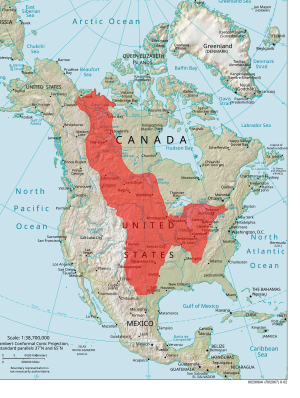 |
| |
GREAT PLAINS REGION[edit | edit source] 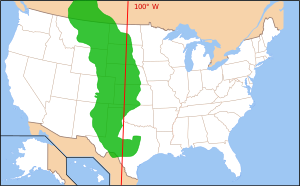 |
| |
ROCKY MOUNTAINS REGION[edit | edit source]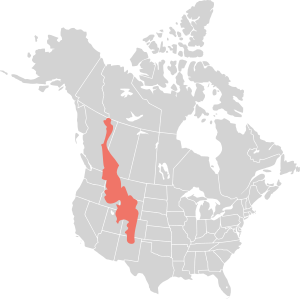  |
| |
BASIN AND RANGE[edit | edit source]   |
| |
PACIFIC COASTAL RANGE[edit | edit source] |
| |
Rivers of the U.S.[edit | edit source]
Virginia maps[edit | edit source]
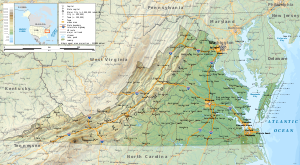 |
